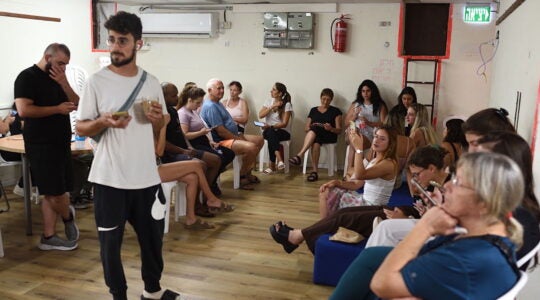You could see the backlash coming.
A yarmulke-wearing rabbi from Yeshiva University goes to the Vatican and finds secret insults to the pope and Jewish mystical codes embedded in Michelangelo’s painting of the Sistine Chapel.
The rabbi, Benjamin Blech, teams up with Roy Doliner, a docent and guide at the Vatican, and their findings are published last week in the book, “The Sistine Secrets,” which claims that Michelangelo was influenced so greatly by Judaism that 95 percent of his painting depicts scenes from the Old Testament.
ABC-TV, likely sensing something sensational after all the attention generated by Dan Brown’s mega-best-seller “The Da Vinci Code” — which claims that Jesus married Mary Magdalene — last week devoted more than an hour on three programs to the new book.
Now, the storm has hit.
Some art historians are claiming that the authors have stolen insights about the painting from other scholars without giving credit, and that they have made assertions that have no basis in fact.
And on a message board set up for viewers of the ABC broadcast “20/20” to weigh in, Blech and Doliner’s findings have triggered some anti-Semitic comments.
“For this rabbi, there is a secret in anything as long as there is money to be made on this baloney,” wrote one viewer on an ABC-TV Web site.
On a white supremacist Web site, someone wrote: “Yet more attacks on Christianity and the Vatican by those deceptive and liars of jews! From the opening, there were 2 jews — beanies and all. A rabbi trying to claim, I mean, lie, that the painting and Michelangelo told a jewish story and not Christian. … WATCH OUT FOR THOSE JEWS! They are in political office, they have power by possessing insane amounts of money, they have been infiltrating the Vatican, they are very very sneaky and deceptive — DO NOT let them ruin such a precious place!”
Rabbi Blech said he saw a Web site in which a blogger claimed, “The Jews are trying to take over the Sistine Chapel.”
Rabbi Blech, who said the book took him and Doliner two years to write, told The Jewish Week that to suggest this is a book “that insults the pope and is insulting to Christianity is totally not true.”
It is more accurate to say that Michelangelo had a “personal animosity towards” Pope Julius II, who commissioned the work in the 15th century, Rabbi Blech said. Michelangelo was primarily a sculptor who was upset at having to stop his sculpting career to paint frescoes, he pointed out. “It ruined his life and his health and he thought the pope was corrupted … and he snuck in two times [figures] giving the finger to the pope,” the rabbi said. The figures are seen with a bent forefinger, which Rabbi Blech says was an obscene gesture.
But Rabbi Blech stressed that his book should be seen as a “bridge between Judaism and Christianity,” and as a “groundbreaking” work in its understanding of “the most important work of art in Western civilization, one that four million people visit each year.”
The book claims that there was Jewish influence in Michelangelo’s painting, particularly from the Kabbalah or mystical aspect of Judaism. Since its publication, it has created a buzz in the art world.
Enrico Bruschini, the official art historian for the U.S. Embassy in Rome, is quoted on the jacket cover as saying the book will “change forever the way to view and, above all, to understand the work of Michelangelo.”
But two other art historians are more critical.
William Wallace, a Michelangelo scholar at Washington University in St. Louis, said in an interview that although the book’s authors “did a certain amount of their homework, they missed an awful lot.” He noted that several years ago there were two essays written about the Sistine Chapel from a kabbalistic point of view.
“Overlooking that kind of scholarship that is very rigorously vetted and published in the field is a little distressing,” he said. “It seems that one of the basic principles of good scholarship … is that you acknowledge what other people have contributed.”
Barbara Wisch, an art historian at SUNY Cortland, pointed out that she was the first to publish the fact that one of the figures in the painting is wearing a badge that Jews were commonly forced to wear in the 15th century.
“One of the fields I work on in the Renaissance is anti-Semitism in the visual culture, and therefore my eyes were attuned and I saw this,” she said, adding that Rabbi Blech and Doliner don’t even mention her in their book.
“A major methodological flaw in this book is that the authors claim discoveries by simply not citing scholarly sources,” Wisch said.
But Rabbi Blech said they were not quoted in their book because “we had been teaching this before they wrote their books.” He said that Doliner discovered the patch “two decades ago and has been expressing this in all of his tours.”
“These are people whose careers are tied up in their works,” the rabbi added. “That is an egotistical and envious response. They can‘t believe that someone else is giving new insights.”
Wisch said that to “suggest that Michelangelo was an expert in Jewish theological writing and a proponent of the Jewish community is to make a leap of faith that cannot be substantiated historically.
“This book under the guise of being new scholarship is not in fact scholarly,” she continued.
“They have no art historical training. They do not know the art historical literature, nor the historical literature and they provide little context for their theories.”
But Rabbi Blech said he has written three books on Jewish and world history and has been a professor of Talmud at Yeshiva University for more than 40 years. Doliner, he said, “has given tours [in Rome and of Vatican museums] with his insights to professors of art and scholars of history for at least two decades.”
“It is rather brazen of them,” he added. “They have no idea what our level of scholarship is. We prove our points in the most important way by actually demonstrating the truths in the work of Michelangelo.”
Wallace said Rabbi Blech and Doliner, have “gone further in their interpretations” than others and have made “some useful observations.”
“But in some way I would say they are stating the obvious,” he added. “This is the Book of Genesis [depicted in the painting]. To discover Jewish individuals and dress is really not surprising.
“Where I disagree with the authors is that this was done because Michelangelo couldn’t get along with the pope. I do not think that a great work of art at the center of the Vatican is the place to get out one’s personal grievances against the pope. The reason why this has survived for 500 years is not because of a personal manifesto of Michelangelo against the pope but because it is a great work of art that resonates through all of history.”
Asked about the authors’ assertion that figures in the painting are giving the pope the finger, Wallace vehemently disagreed.
“There are all kinds of gestures,” he said. “We cannot cherry pick on details in a great piece of art and make an overall interpretation based on details. By rule of thumb, the meaning is in the foreground and it is foremost. That is the primary meaning. The background and single gestures or single details tend to reinforce major and important meanings but do not necessary hide secret meanings.”
The authors also point out that a little-noticed aspect of the Sistine Chapel is that Stars of David — then called Seals of Solomon — adorn the floor of the chapel. In addition, they noted that the Sistine Chapel is built to the exact dimensions of the original Temple in Jerusalem — including the Holy of Holies that only the high priests were allowed to enter on Yom Kippur.
Rabbi Blech insisted that the “foremost authority on Michelangelo is Enrico Bruschini, who raves about our insights and contributions.”
But Wallace pointed out that individuals “bring an awful lot of ourselves to great works of art” and therefore can see different things in the art.
However, he added, “it’s very rare that artists are engaging in a kind of hidden symbolism or in a signature in a finger arrangement. Those are clever ideas of later centuries. … I’m bothered by the use of the word secrets.
“This sells a lot of books in the modern world, but it is not what Renaissance art was trying to accomplish, especially in the Vatican, the center of the papacy.”
The New York Jewish Week brings you the stories behind the headlines, keeping you connected to Jewish life in New York. Help sustain the reporting you trust by donating today.




